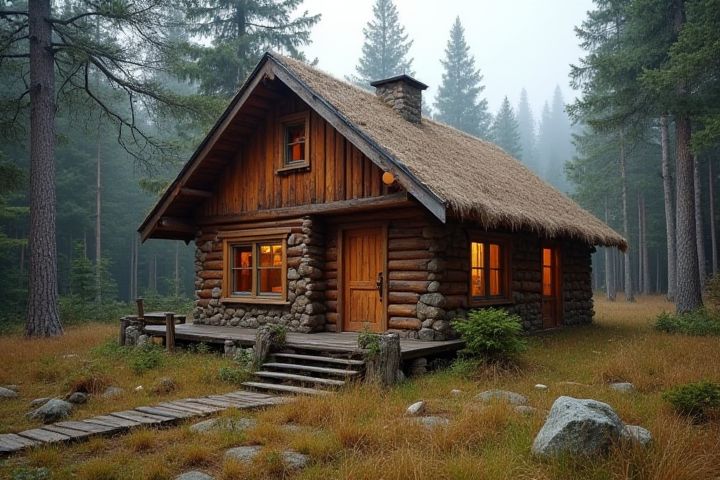
Living in a wooden house can be safe, but it largely depends on various factors such as construction quality, maintenance, and local environmental conditions. Well-constructed wooden homes can provide excellent insulation, energy efficiency, and aesthetic appeal. However, you should consider risks like termites, mold, and fire hazards, which can compromise the structure's integrity. Regular inspections and treatments will help prevent potential problems related to pest infestations and moisture. With proper care and adherence to safety regulations, your wooden house can remain a safe and cozy living environment.
Is It Safe To Live In A Wooden House
Proper fire safety measures
Living in a wooden house can be safe when proper fire safety measures are implemented. Installing smoke alarms in every room, testing them monthly, and replacing batteries at least once a year can significantly reduce fire risks. Having a fire extinguisher easily accessible in key areas, such as the kitchen and garage, ensures you're prepared for small fires. You should also create and practice a fire escape plan, ensuring all family members are familiar with exit routes and safe meeting points outside.
Pest and termite control
Living in a wooden house can be safe if effective pest and termite control measures are implemented. Regular inspections for signs of wood-destroying insects, such as termites, ants, and beetles, are crucial in maintaining your home's structural integrity. You can enhance protection by applying chemical treatments, installing barriers, and ensuring proper drainage around the foundation to prevent moisture accumulation. Investing in regular pest control services will help you safeguard your wooden structure against infestations, keeping your environment healthy and secure.
Good insulation properties
Wooden houses are renowned for their excellent insulation properties, which can significantly enhance energy efficiency. With an R-value ranging from 1.41 to 4.0 per inch, wood provides natural thermal resistance, keeping your home warm in winter and cool in summer. This insulation capability reduces the need for heating and cooling systems, potentially lowering your energy bills by up to 30%. When combined with proper sealing and insulation materials, a wooden house can maintain a comfortable environment while minimizing environmental impact.
Structural integrity standards
Wooden houses can be safe when built according to strict structural integrity standards, which include adherence to building codes and guidelines set by organizations like the International Code Council (ICC) and the American Wood Council. Proper treatment and maintenance of the wood, such as using pressure-treated timber and regular inspections for pests or moisture, can enhance durability and safety. In seismic zones, engineered wood solutions, such as cross-laminated timber, provide additional strength and resilience against natural disasters. Your wooden home should meet local regulations, ensuring a safe living environment that can withstand environmental challenges.
Regular maintenance necessities
Living in a wooden house can be safe, provided you prioritize regular maintenance. Inspections should occur at least twice a year, focusing on areas like roofing, siding, and foundation to prevent water damage or pest infestations. Regular treatments with preservatives and sealants can protect wood from decay, while checking for signs of mold or termites every six months adds to your home's resilience. Keeping gutters clean and ensuring proper drainage will help preserve the longevity and safety of your wooden structure.
Resistance to natural disasters
Wooden houses can offer a degree of resistance to natural disasters, especially when designed and constructed with specific safety features. In regions prone to earthquakes, engineered wood structures often flex and absorb seismic forces better than rigid materials like concrete or brick. For areas at risk of hurricanes, houses built with reinforced timber frameworks and impact-resistant windows can withstand high winds and flying debris. It's essential to consider local building codes and choose quality materials to enhance the safety of your wooden home against potential disasters.
Environmental impact
Living in a wooden house can have a positive environmental impact due to the use of renewable resources, as timber is biodegradable and can be sustainably managed through responsible forestry practices. Wooden homes often have lower carbon footprints compared to those built with concrete or steel, contributing to reduced greenhouse gas emissions during construction. Properly maintained, wooden structures can last for generations, minimizing waste and the need for frequent renovations. However, to ensure safety and durability, it is crucial to address potential issues like pests and moisture, emphasizing the importance of sustainable building techniques.
Energy efficiency
Living in a wooden house can be energy-efficient, as wood is a natural insulator that helps regulate temperature and reduce heating costs. The structural properties of timber allow for better air circulation, contributing to a more comfortable living environment while minimizing reliance on artificial heating and cooling systems. Furthermore, well-insulated wooden homes can achieve high levels of energy efficiency, reducing your overall carbon footprint and energy bills. To maximize energy savings, consider implementing sustainable building practices, such as using energy-efficient windows and advanced insulation materials.
Cost-effectiveness
Living in a wooden house can be cost-effective due to lower material costs and energy efficiency. Wood has natural insulating properties, which can reduce heating and cooling expenses, leading to long-term savings on utility bills. Furthermore, maintenance costs may be lower if high-quality, treated wood is used, as it can resist pests and decay effectively. You should also consider potential insurance savings, as some insurers offer discounts for wooden homes built with modern safety standards.
Aesthetic appeal
Living in a wooden house combines aesthetic appeal with a unique charm, often enhancing your home's beauty with natural textures and warm hues. Wood's versatility allows for various architectural styles, from rustic log cabins to sleek modern designs, catering to diverse tastes. The natural grains and patterns in wood create inviting interiors, contributing to a cozy atmosphere that can increase emotional well-being. With proper maintenance and treatment, a wooden house can be both stunning and resilient, providing a visually captivating living environment.
